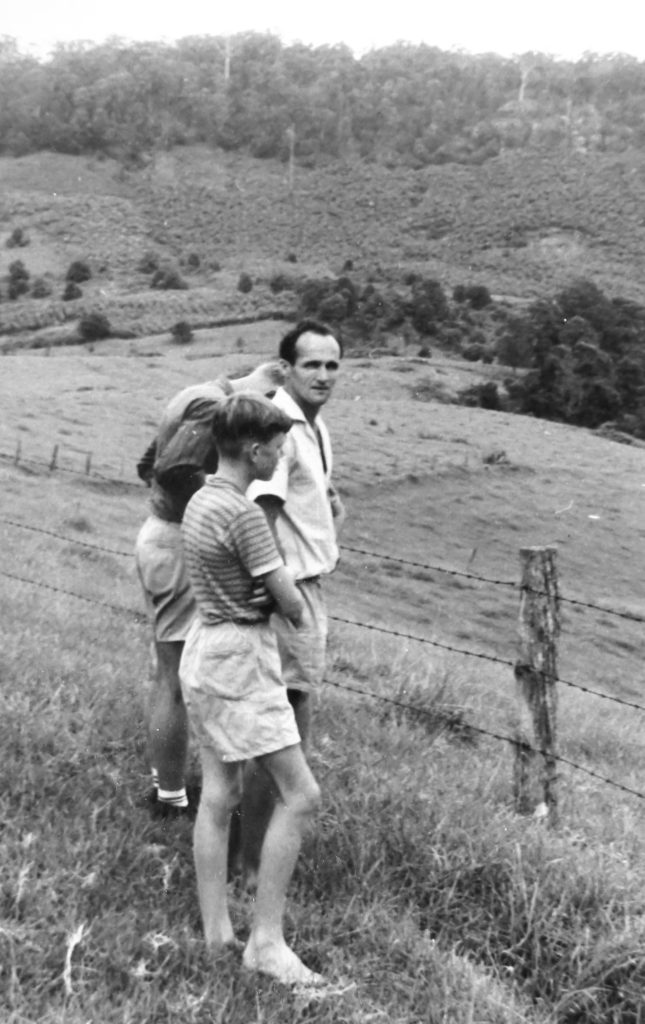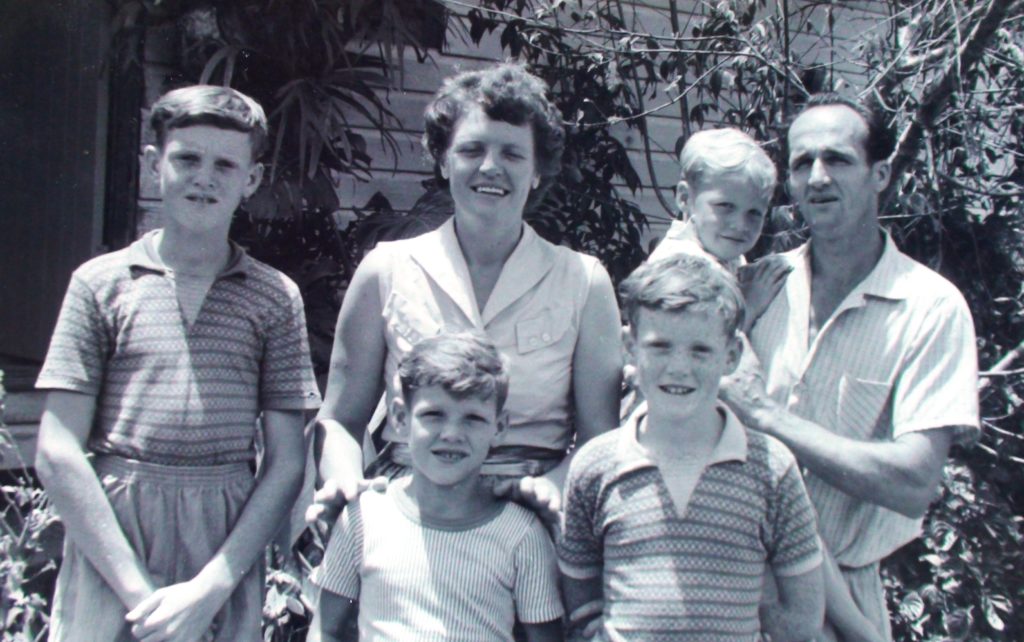
Dad with unknown person and Ken who was only about twelve years old in the early 1960, looking up the Wilsons Creek valley over the top of the newly constructed fence (see the story below).

The Aitken Family: Ken, Norma, and Dad holding Colin who was only a little child. Rick and Gerald are in the foreground.
____________________________________________________________________________
Whenever we would drive the three kilometers from our house up to the main Wilsons Creek road which was a metalled and bitumen road, or to come home, we would drive through a dairy farm owned by Mr. Whiteman. It was pleasant driving through these open grassed paddocks.
Mr. Whiteman lived in a white-painted house with his wife and three children on the hill as you entered off the main Wilsons Creek road. His dairy shed and cow yards were about 200 meters beyond the house on the same hill. His dairy cows roamed over open grassed paddocks.
We just traveled over open grass tracks over open grassed paddocks. The tracks finally narrowed as they came down to Wilsons Creek. Then it turned on itself and came through a low level coarse gravelly crossing. The creek was really beautiful. It was a rainforest creek of large still pools than another all connected by a series of bouldery rapids. There was a point where the track dipped down and crossed the creek where there was only a heavy gravel bottom. Dad had worked on the crossing by removing any man-handleable rocks. This left a heavy gravel bottom with no bigger stones than 75 mm in size.
The crossing then became a 50-meter muddy track which led up to the house. Sometimes after periods of rain, the track would become very muddy with free water on the surface of the track. However, when the short-wheelbase Land Rover was engaged in four-wheel drive, the vehicle could easily get up to the house.
Over one year in the early 1960’s Mr. Whiteman began to get very cross that we were cutting across his land. It got to the point that we came home from church one weekend and Mr. Whiteman had felled a small tree across the entrance to our low-level crossing. This meant we couldn’t cross to get up to our house. We had to back out and travel back up to the Wilsons Creek road. We drove on a bit further to another neighbor’s driveway which led to Browns House. Brown’s Road as we knew it is now called Black Bean Road.
Blackbean or Moreton Bay Chestnut trees are wonderful broad-leaved rainforest trees that have beautiful orange flowers and very big black seeds in long 300 mm pods. Browns had come out to Wilsons Creek in the bullock trail days of the early 1900’s to clear their land, grow bananas on the steep slopes and build their big house with its cream painted weatherboard sides, galvanized tin roof and big wide verandas.
They had sold the property to someone else in 1995. Their road was very extensive and led over the hill where their house was and down to another house where the Grahams lived. Then the driveway went on further, down over a little creek that eventually flowed into the main creek. The driveway went over some slopes to where the Knights had a house up to 1954 when a big landslide came against their house in the middle of a big cyclone. We went up a small hill and through into our property. We had arrived home after a bit of a detour!
Dad cut the chopped branch across the crossing the next day and went into Mullumbimby to see the property people. He came back with a document that showed we had an easement from the main Wilsons Creek road, across the farm and down to the creek leading up to our house. Dad was free to fence the easement on both sides. Mr. Whiteman, being difficult in turning against us in a small way, it became very detrimental to him with the future fencing we did as it turned out that we had an easement across his land.
Soon after this decision to fence the easement, Dad went up into the bush on the Koonyum Range. The Koonyum Range was a range of forested hills on the northern side of us, right above the main Wilsons Creek road. Dad would often go up there to get firewood and cut stringy-bark fence posts. Dad had obtained permission to get these things from an owner of a large forested area up there. He would go up there in his large 4 wheel drive Landrover to get posts and firewood. Chainsaws had just come on the market in the early 1960s. He had exchanged the short-wheelbase Land Rover for the larger version. Dad cut down various stringybark trees for posts into 2.0 meter lengths and loaded them onto the Land Rover. Stringybark is a eucalyptus tree and is a very good timber for posts in the ground. He brought them down to the house to split off the bark and split the logs into fence posts using steel wedges. He would probably get three to four fence posts from each log. The bark I later used to make my treehouse construction in the big Teak tree near the garage.
He then took these fence posts right up to the alignment of the easement up at the Wilsons Creek road on both sides. He then worked backwards away from the main road. He had a friend of ours, Cal, who had a tractor with a fence boring unit to come and dig a whole series of post holes for the fence. He then placed the fence posts into the hole, aligned them correctly, filled the hole with the dugout earth and progressively rammed the earth tight with the head of a crowbar.
Then when there were about ten posts in place, he then aligned a series of three twenty millimeter holes in each, drilling them with a manual drilling tool. Electric drills hadn’t been invented then and then there was no electricity available. The holes were for the placement of barbed wire along the entire length of the fence.He worked his way slowly from the Wilsons Creek road down to the causeway over the Wilsons Creek creek to our house. There were many posts over three kilometers of our easement. There were periodic gates in the fence on either of the easement to allow for Mr. Whiteman to move his dairy cattle from one paddock to another and herd them up to the dairy for milking.
Instead of just moving the cattle continuously across the paddock, he had now had to open two gates and carefully moved the cattle from one paddock to the next. He had to ensure the cattle didn’t go out on the easement and take a lot more time in herding them up to the dairy for milking. The simplicity of Mr. Whiteman moving his cattle across one paddock in one go, now became very complicated in moving his cattle through a set of gates.
________________________________________________________________________________________________________________
